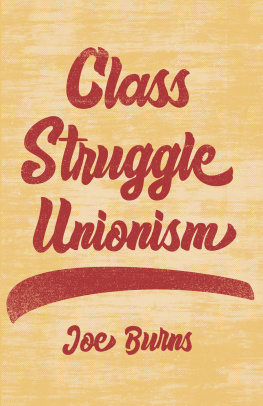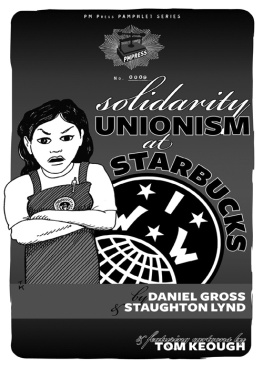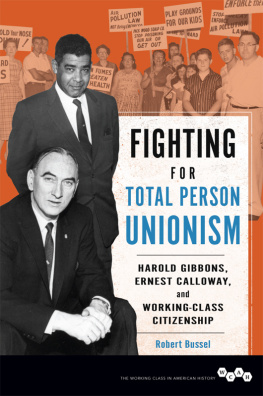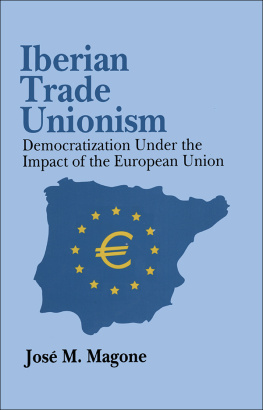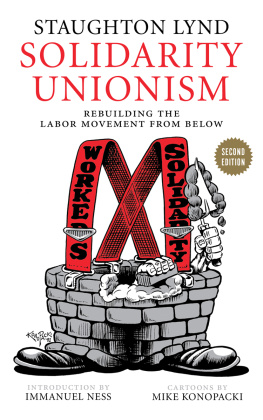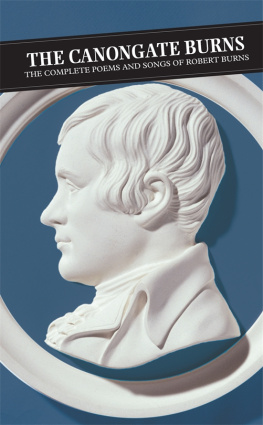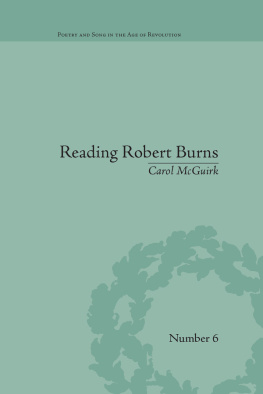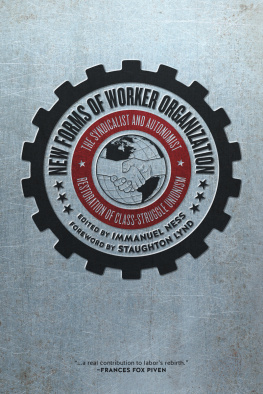Joe Burns - Class Struggle Unionism
Here you can read online Joe Burns - Class Struggle Unionism full text of the book (entire story) in english for free. Download pdf and epub, get meaning, cover and reviews about this ebook. year: 2022, publisher: Haymarket Books, genre: Politics. Description of the work, (preface) as well as reviews are available. Best literature library LitArk.com created for fans of good reading and offers a wide selection of genres:
Romance novel
Science fiction
Adventure
Detective
Science
History
Home and family
Prose
Art
Politics
Computer
Non-fiction
Religion
Business
Children
Humor
Choose a favorite category and find really read worthwhile books. Enjoy immersion in the world of imagination, feel the emotions of the characters or learn something new for yourself, make an fascinating discovery.
Class Struggle Unionism: summary, description and annotation
We offer to read an annotation, description, summary or preface (depends on what the author of the book "Class Struggle Unionism" wrote himself). If you haven't found the necessary information about the book — write in the comments, we will try to find it.
Joe Burns: author's other books
Who wrote Class Struggle Unionism? Find out the surname, the name of the author of the book and a list of all author's works by series.
Class Struggle Unionism — read online for free the complete book (whole text) full work
Below is the text of the book, divided by pages. System saving the place of the last page read, allows you to conveniently read the book "Class Struggle Unionism" online for free, without having to search again every time where you left off. Put a bookmark, and you can go to the page where you finished reading at any time.
Font size:
Interval:
Bookmark:
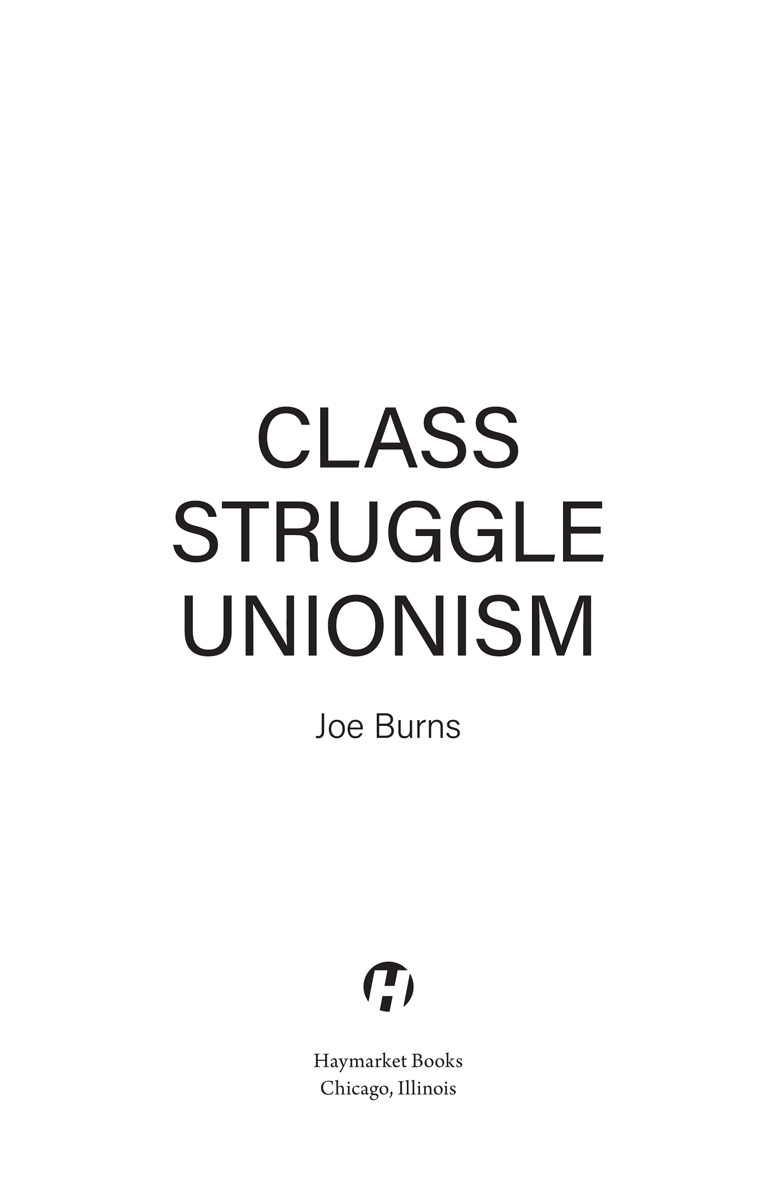
2022 Joe Burns
Published in 2022 by
Haymarket Books
P.O. Box 180165
Chicago, IL 60618
773-583-7884
www.haymarketbooks.org
ISBN: 978-1-64259-681-6
Distributed to the trade in the US through Consortium Book Sales and Distribution (www.cbsd.com) and internationally through Ingram Publisher Services International (www.ingramcontent.com).
This book was published with the generous support of Lannan Foundation and Wallace Action Fund.
Special discounts are available for bulk purchases by organizations and institutions. Please call 773-583-7884 or email for more information.
Cover design by Eric Kerl.
Library of Congress Cataloging-in-Publication data is available.
To Melissa
Introduction
To revive the labor movement, we need to revive class struggle unionism. Class struggle unionism is a form of unionism that challenges the control over our society by the superrichthe handful of billionaires who own the vast majority of resources in the United States and the world. Every part of class struggle unionism, from the guiding ideas to strike tactics to organizing techniques, is shaped by an understanding of this class struggle.
For one hundred years up until the 1990s, class struggle unionism was the main alternative to bureaucratic business unionism. The dividing line between business unionism and class struggle unionism was simple: whether you accepted the very right of management to exploit labor of working people. The business unionists said sure, as long as they got a fair days pay for a fair days work, they would accept managements control of the workplace and the economy. Class struggle unionists said no, labor creates all wealth, and viewed their unionism as one part of a bigger struggle against the billionaire class.
In the coming chapters we will discuss how billionaires are created. Understanding why and how billionaires exist leads to a very distinct and complete framework of unionism. Class struggle unionism as a philosophy aims big, for the abolition of the billionaire class. As such, it rejects a small-ball approach to union issues. Class struggle unionists believe in militancy, shop floor struggle, union democracy, fighting the system, and prioritizing antiracist struggle.
Class struggle unionism is responsible for some of the brightest moments in labor history. It motivated the Industrial Workers of the World in their brand of revolutionary unionism, which contributed to some of the greatest strikes in US history. The great socialist leader Eugene Debs moved from conservative railroad business unionism to socialism through participation in class struggle. The key militants in the great strikes of 1934 in Minneapolis, Toledo, and the West Coast were class struggle unionists. Adherents built a civil rights unionism in the US South following World War II.
One of the key weaknesses of the labor movement since the early 1990s is the absence of a broad-based, explicit class struggle union trend. When I entered the labor movement in the 1980s, I got the tail end of such a trend. Coming out of the great upsurges of the 1960s the civil rights, antiwar, and womens movementsthousands of socialists joined the labor movement, explicitly adopting a class struggle union framework. It drove unionists to ground themselves in rank-and-file unionism, bringing us enduring institutions such as Teamsters for a Democratic Union, Labor Notes, Black Workers for Justice, and many other rank-and-file-oriented institutions.
I will argue in this book that for the first time in US labor history, class struggle unionism has been eclipsed as the main alternative to business unionism, replaced by an approach that I call labor liberalism. While this approach focuses on organizing techniques and ties to the community, it lacks critical components of class struggle unionism, including a willingness to challenge the union bureaucracy, shop floor militancy, rank-and-file democracy, and an overall opposition to the system of capitalism.
We need to have a sober assessment of the situation we face and our prospects going forward. We are getting our asses kicked. Only six out of a hundred private-sector workers belong to unions. Most major industries such as trucking, residential construction, retail, and finance are virtually non-union. Where remnants of unionism do exist, such as meatpacking, the established unions are bureaucratic and ineffectual. Our contracts have been decimated, and once-strong pensions and health-care programs have been gutted. Optimism only goes so far, and at some point realism needs to take hold.
Lets be honest. We have no plan to revive the labor movement. For several decades, we have attempted to revive unionism within a political and legal system set up to benefit the billionaire class. Its not working. The owners of industry take in billions and billions of profits, creating a class of people with unimaginable economic and political power. Money is power. For unionists, this power shapes our unionism in more ways than we care to admit.
In my previous books, Reviving the Strike and Strike Back, I looked back to labor history to argue that we need to revive the strike. I argued that in both the 1930s for private workers and the 1960s for public-sector workers, the strike was the indispensable tactic that helped win our unions. Here, likewise, we can look to labor history to demonstrate the power of a unionism shaped by class struggle principles.
Those of us who want a militant, democratic, antiracist, antisexist, and fighting labor movement have a choice. Piecemeal reform is not going to work. Our unionism must become a lot more bold, a lot more radical, a lot more strategic, and a lot less willing to accept the status quo. We need a new framework.
Over my thirty-plus years of labor activism and bargaining, I have found inspiration from working people coming together to strike back against management. Today, there are signs of hope. In recent years we have witnessed teachers in states such as West Virginia, Oklahoma, and Arizona striking statewide and the growth of pro-working-class politics represented by the Bernie Sanders campaigns and the growth of the Democratic Socialists of America. We have millions of youth taking to the streets to demand Black Lives Matter.
We have an opportunity to build a new type of labor movement. But we cannot build it based on the tired ideas of the last three decades. The billionaire class is powerful, organized, and vicious. To take them on we need our own philosophyclass struggle unionism.
Chapter 1
Shop Floor Economics
Class struggle unionism places our union struggles as part of a larger struggle between the two major classes in society, the working class and the owning class (also called the 1 percent or the billionaire class). Rather than taking on individual bad employers, class struggle unionists fight the entire class of billionaires who control our economy and our government. For that reason, our discussion must begin with an analysis of these two basic classes in society.
Working people are the vast majority of the population. Working people are truck drivers, clerical workers, baristas, restaurant workers, teachers, nurses, carpenters, and autoworkers. The working class holds little income-producing wealth and must work for others in order to get by. A relative handful belong to unions, but almost 90 percent work in non-union workplaces.
Professor Michael Zweig includes in the working class
those people with relatively little power at workwhite-collar bank tellers, call-center workers, and cashiers; blue-collar machinists, construction workers, and assembly-line workers; pink-collar secretaries, nurses, and home-health workersskilled and unskilled, men and women of all races, nationalities, and sexual preferences. The working class are those with little personal control over the pace or content of their work and without supervisory control over the work lives of others.
Next pageFont size:
Interval:
Bookmark:
Similar books «Class Struggle Unionism»
Look at similar books to Class Struggle Unionism. We have selected literature similar in name and meaning in the hope of providing readers with more options to find new, interesting, not yet read works.
Discussion, reviews of the book Class Struggle Unionism and just readers' own opinions. Leave your comments, write what you think about the work, its meaning or the main characters. Specify what exactly you liked and what you didn't like, and why you think so.

